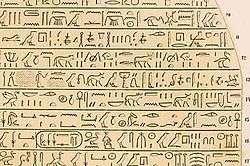Khabash
| Khabash | ||||||||||||||||||||||||||||||||||||||||||||||||
|---|---|---|---|---|---|---|---|---|---|---|---|---|---|---|---|---|---|---|---|---|---|---|---|---|---|---|---|---|---|---|---|---|---|---|---|---|---|---|---|---|---|---|---|---|---|---|---|---|
| Khababash, Khabbash | ||||||||||||||||||||||||||||||||||||||||||||||||
|
Part of the Stela of Nastasen mentioning (row 13) the Egyptian invader Kambasuten (most likely Khabash)[2] | ||||||||||||||||||||||||||||||||||||||||||||||||
| Pharaoh | ||||||||||||||||||||||||||||||||||||||||||||||||
| Reign | c.338 – c.335 BCE (31st Dynasty[3]) | |||||||||||||||||||||||||||||||||||||||||||||||
| Predecessor | Artaxerxes III | |||||||||||||||||||||||||||||||||||||||||||||||
| Successor | Artaxerxes IV or Darius III | |||||||||||||||||||||||||||||||||||||||||||||||
| ||||||||||||||||||||||||||||||||||||||||||||||||
Khabash, also Khababash or Khabbash, resided at Sais in the fifth nome of Lower Egypt in the fourth century BCE. During the second Persian occupation of Egypt (343–332 BCE) he led a revolt against the Persian rule in concert with his eldest son, from ca. 338 to 335 BCE, a few years before the conquest of Egypt by Alexander the Great.[5] It is said that Nectanebo II, the exiled last native ruler of Egypt, may have helped in these events, but was possibly sidelined for good as a result of the failure of the revolt.
Little is known about Khabash. He is referred to as "Lord of both lands",[6] i.e. King of Upper and Lower Egypt, and as "Son of Ra", another pharaonic title, and given the throne name of Senen-setep-en-Ptah in a decree by Ptolemy Lagides,[7] who became King Ptolemy I Soter in 305 BCE.
Sometime in the 330s BCE, an Egyptian ruler called Kambasuten – who is widely recognized as Khabash – led an invasion into the kingdom of Kush which was defeated by king Nastasen as recorded in a stela now in the Berlin museum. An Apis bull sarcophagus bearing his name was found at Saqqara[8] and dated to his regnal Year 2.[9]
References
- ↑ Henri Gauthier, Le Livre des rois d'Égypte, IV, (=MIFAO 20), Cairo, 1916, p. 139 (here misinterpreted as Cambyses II).
- ↑ Henri Gauthier, Le Livre des rois d'Égypte, IV, (=MIFAO 20), Cairo, 1916, p. 139 (here misinterpreted as Cambyses II).
- ↑ Placed in this dynasty only for chronological reasons, as he was not related to the Achaemenids.
- ↑ Henri Gauthier, op. cit., p. 196.
- ↑ Phiroze Vasunia, The Gift of the Nile: Hellenizing Egypt from Aeschylus to Alexander, University of California Press 2001, p.266
- ↑ Records of the Past Being English Translations of the Assyrian and Egyptian Monuments, Adamant Media Corporation 2001, p.73
- ↑ The decree of Ptolemy Lagides
- ↑ Karl Baedeker, Egypt, Adamant Media Corporation 2000. p.130
- ↑ Samuel Birch, Ancient history from the monuments. Egypt from the earliest times to B.C. 300, Society for Promoting Christian Knowledge 1883, p.189
